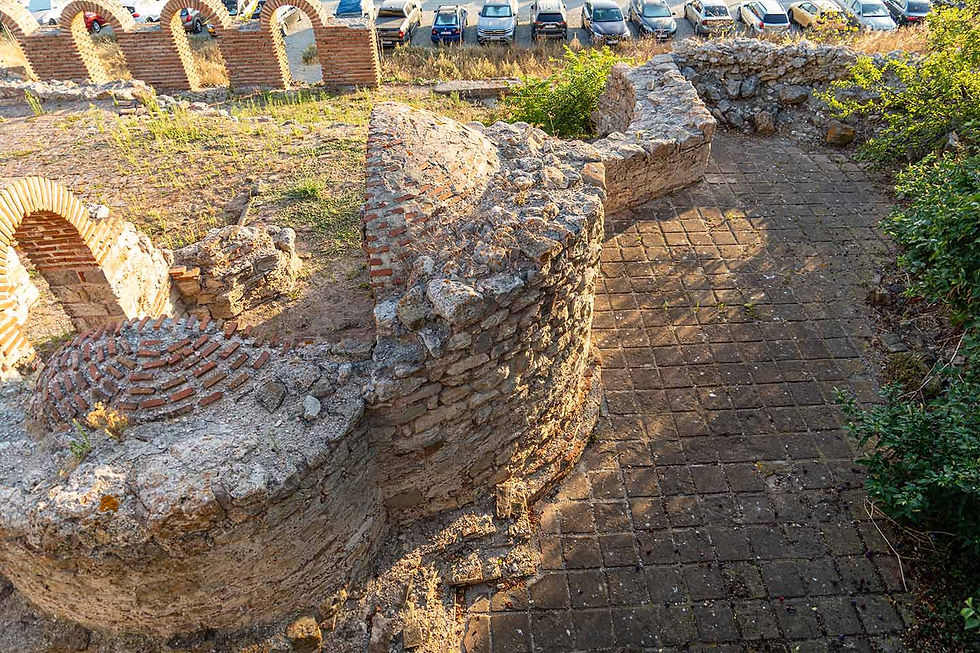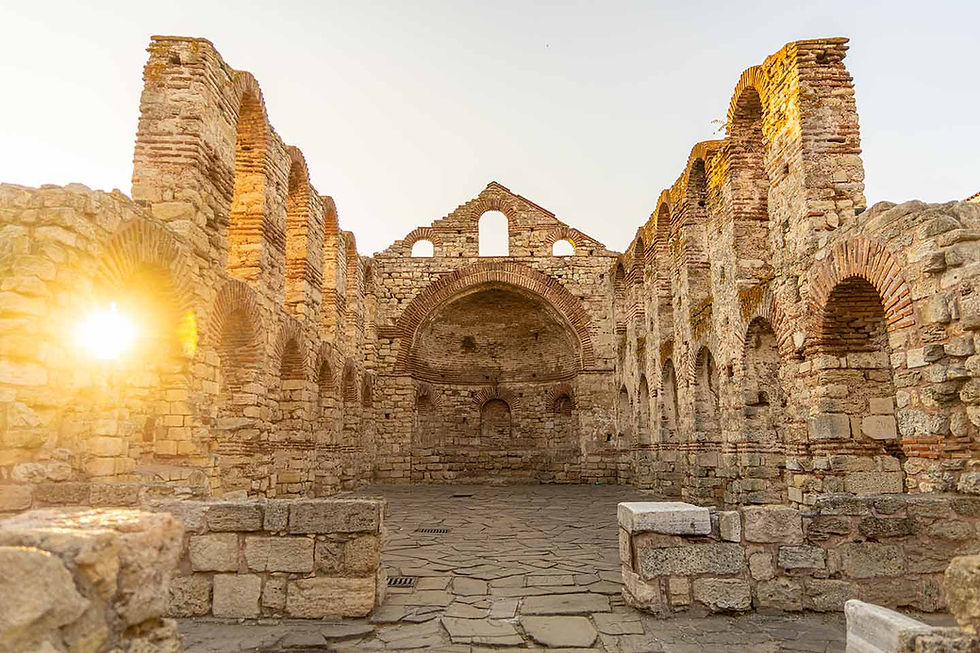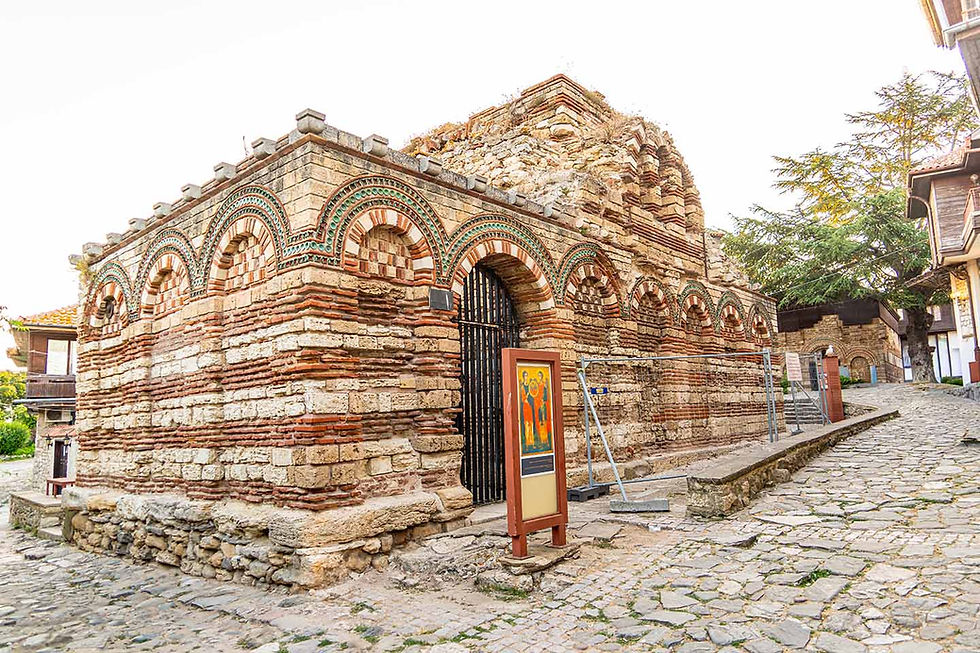The oldest Nessebar church – Basilica of the Holy Mother of God Eleusa (Tenderness) – one of the most important historical and archaeological monuments in Nessebar
- Stefan Ivanov

- 2 days ago
- 10 min read
The Basilica of the Holy Virgin Eleusa, also known as "Tenderness", is one of the most ancient and significant architectural monuments located in the Old Town of Nessebar.

This site is not just another tourist attraction, but a key archaeological monument, the study of which reveals significant layers of the early Christian and medieval history of the city. Due to its age, which positions it as probably the oldest Nessebar church, it offers valuable data on the cultural and religious life of ancient Mesembria and the Byzantine period.
Origin of the name "Eleusa" (Compassion)
The name of the basilica, "Eleusa", comes from the Greek word Παναγία Ελεούσα, which in translation means "Compassion", or bestowing love and tenderness. This term is not accidental, but describes one of the most popular and beloved iconographic types of the Holy Virgin. In iconography, "Eleusa" is distinguished by the tender image of the Mother of God, who holds the Infant Jesus, who has touched her cheek, expressing an intimate and warm bond of maternal love.
Exact location and topography
The basilica is located on the northeastern rocky slope of the Nessebar Peninsula, positioned on the edge of the land, from where there is a wide view of the sea.

Its location, outlined against the backdrop of the sea horizon, is a key element that determines its fate. The proximity to the sea is the main factor that leads to the destruction of a significant part of the building. Continuous marine abrasion and fluctuations in sea level gradually eroded the rocky shore, as a result of which the northern nave and part of the central nave of the basilica sank into the sea. This interaction between geography and the history of the monument is essential for understanding its current state.
The dating dispute
The study of the basilica reveals a discrepancy in the dating of its initial construction. Some sources claim that it was built in the 5th century, citing brick seals from the time of Emperor Justinian. At the same time, other sources categorically indicate the 6th century as the period of its construction.

The most thorough studies have established that the basilica was built in the mid-6th century. Brick seals bearing the name of Emperor Justinian I, who ruled from 527 to 565 AD, were used in the construction. This period covers both the late 5th and early 6th centuries, which explains the apparent discrepancy. Therefore, the most likely hypothesis is that construction began in the 5th century and was completed or renovated in the mid-6th century during Justinian's reign. This precision in dating is extremely important for the accurate positioning of the basilica in the historical context of Byzantium and for understanding its role in early Christian architecture.

First phase (5th – 6th century) – initial construction of the basilica and monastery, probably completed in the mid-6th century during the reign of Emperor Justinian I.
Second phase (8th – 9th century) – cessation of liturgy, possibly due to iconoclastic disputes, the conquest of the city by the Bulgarians, or restoration under Emperor Basil I.
Third phase (1341 – 1342) – second and final renovation. Only the southern nave was used for liturgical purposes, which is associated with damage caused by sea erosion and earthquakes.
Final abandonment (after the 14th century) – after the Ottoman invasion, the basilica was abandoned and burned, and subsequent earthquakes (1352, 1688, 1778, 1855) made restoration impossible.
Architectural plan and dimensions
The Basilica of the Holy Virgin Eleusa is built according to the classical plan of a three-aisled basilica with three apses and a narthex.

Its dimensions are impressive for the era, with a length of 28 meters and a width of 18 meters. One of the most distinctive and unique features of the building is the presence of two smaller apses, located in the northern and southern aisles. This architectural feature distinguishes it from many other early Christian basilicas.
Evolution of the altar space
The construction of the basilica in the second half of the 6th century coincides with a period of evolution in Christian ritual, which is directly reflected in its architectural design. Studies have shown that the complex layout of the altar space is a direct response to the more complicated process of offering the gifts for the Eucharistic sacrament. This is a key academic observation, as it shows that architecture is not simply a static form, but a dynamic response to the changing needs of the religious community. The Basilica of Eleusis thus serves as an important example of the relationship between architectural design and liturgical practice in early Christianity.

To understand the uniqueness of the Basilica of Eleusa, it is useful to make a comparison with other significant churches in Nessebar. The comparison shows that the Basilica of Eleusa, with its three apses and unique additional apses in the side aisles, is representative of a different, earlier architectural style compared to the Church of St. Sophia, which has a single apse and an atrium.

While "St. Sophia" is a large metropolitan church, the Basilica of Eleusa is part of a monastery complex. This differentiation emphasizes the diversity of religious sites in Nessebar and demonstrates the unique early Christian identity of the Basilica of Eleusa within the urban cultural landscape.
Archaeological research and finds
Archaeological research of the Basilica of "St. Mother of God of Eleusa" began at the beginning of the 20th century, with the first excavations being carried out in 1920. They were the work of the prominent Bulgarian archaeologists Ivan and Velizar Velkovi, whose work laid the foundations for a comprehensive understanding of the monument. It is their research that reveals the complex history of the building, which has gone through several phases of destruction and renovation.
The three main phases of existence
Based on archaeological data, three main periods of the basilica's existence have been traced:
First phase - the initial construction in the middle of the 6th century. The building was built as a three-nave basilica, part of an early Christian monastery complex.
Second phase: the first renovation of the temple took place in the 8th-9th centuries. The reasons for this interruption of the liturgy are multifaceted and are probably related to historical events such as the iconoclastic period, the conquest of the city by the Bulgarians and the subsequent restoration of the city of Mesembria under Emperor Basil I. An inscription from 879 attests to restoration activities, which gives high historical credibility to this period.
Third phase: the second and last significant renovation was documented in 1341-1342. This is confirmed by a founding inscription mentioning Tsar Ivan Alexander's uncle. Due to the destruction caused by the erosion of the coast, only the southern nave of the basilica was used for liturgical purposes.

Archaeological study of the necropolis
A necropolis also belongs to the monastery basilica, the study of which provides valuable information about the life of the community. Archaeological data reveal the presence of two main periods of burials.
Early necropolis - a small necropolis was discovered to the west of the building, which functioned in the 7th century. It consists of burials surrounded by stones or covered with stone slabs, as well as ordinary burial pits.
Late necropolis - a later necropolis from the 13th-14th centuries is located to the east of the church, and lay people were buried in it. The presence of coins from the Komnenian dynasty and fragments of vessels with the monogram of Michael Shishman in stone tombs dates this necropolis and proves the continued role of the basilica as a spiritual center for the population in the Middle Ages. The chronology of the necropolis is a direct reflection of the history of the basilica, testifying to its existence and functioning during various periods of destruction and reconstruction.

Marine erosion and seismic activity
The destruction of the Basilica of Eleusis is the result of a complex process in which history collides with natural forces. A major factor is its location on the edge of a rocky shore, which exposes it to constant marine erosion and fluctuations in sea level. As a result of this erosion, the northern part of the basilica collapsed into the sea. An additional catalyst for the destruction were several powerful earthquakes recorded in 1352, 1688, 1778 and 1855. These seismic events made it impossible to rebuild the abandoned temple after the Ottoman invasion, when it was burned down and turned into a garbage dump.

Conservation and Restoration
Despite significant damage, the basilica has been preserved for future generations thanks to extensive conservation and restoration efforts. These activities began with excavations in 1920 and have continued over the years. Today, the basilica is preserved and partially restored. This conservation approach, which focuses on preserving the authentic appearance of the ruins rather than on complete restoration, is characteristic of contemporary practices in the field of cultural heritage. Church conservation projects in Nessebar, organized in cooperation with international organizations such as ICOMOS and municipal institutions, reflect Bulgaria's commitment to preserving its heritage. In addition, the work of institutions such as the National Archaeological Institute and Museum, which encourages interdisciplinary research in conservation and restoration processes, ensures that work on monuments such as the Basilica of Eleusa is carried out with maximum scientific precision.
The Basilica's Place in the Nessebar Cultural Landscape
The Basilica of the Holy Virgin Eleusa is one of the most important historical and archaeological monuments in Nessebar, offering multi-layered information about the early Christian and medieval periods. It is a testament to dynamic processes of construction, destruction and renewal, shaped by religious, historical and natural factors. Its architecture is a direct reflection of the evolution of liturgical practices, and its fate is inextricably linked to the geological features of the Nessebar peninsula.
In the rich cultural landscape of Nessebar, the Basilica of the Holy Virgin Eleusa occupies a unique place. It is one of the oldest churches, along with St. Sophia, and is an important example of early Christian basilica architecture.

While Hagia Sophia served as the city's cathedral and metropolitan residence, Eleusis is part of a monastery complex, which highlights the diversity of church life in the city. The condition of these ancient temples, which are now ruins or preserved remains, contrasts with the only functioning church in the Old Town - the Assumption of the Virgin Mary, built in 1873. However, this contrast is not a rupture, but rather a testament to the continuity of religious life in Nessebar, which continues to be a spiritual center for Christians.
Despite the extensive research, there is still potential for future research. Expanding underwater exploration in the area of the sunken part of the basilica may reveal new details about its architecture and history. Additional excavations of the adjacent necropolis could also provide more information about the life and rituals of the medieval community. For the long-term preservation of the monument, given the ongoing marine erosion and seismic hazard, it is recommended to develop comprehensive strategies for sustainable conservation, using the most modern interdisciplinary methods and technologies. The preservation of the Basilica of the Holy Virgin Eleusa is of critical importance not only for Nessebar, but also for the overall understanding of early Christianity in Southeast Europe.
In 1927, the Basilica of the Holy Virgin Eleusa (Tenderness) was declared a folk antiquity.
In 1964, the Basilica of the Holy Virgin Eleusa (Tenderness) was declared an architectural and construction monument of culture with the category of national importance.
Nessebar - a journey through time, embraced by the sea and whispering stories
Sometimes we need to stop for a moment, leave the hectic everyday life behind us and immerse ourselves in an atmosphere where time has stopped.

Ancient Nessebar is just such a place.

Situated on a small, rocky peninsula, connected to the mainland by a narrow strip of land, this city is like a treasure trove, protected by the waves of the Black Sea.

Nessebar is located:
412 kilometers (about 3 hours and 59 minutes by car) from the capital
277 kilometers (about 2 hours and 55 minutes by car) from the city of Plovdiv
100 kilometers (about 1 hour and 48 minutes by car) from the city of Varna
35 kilometers (about 36 minutes by car) from the city of Burgas
The ancient town of Nessebar is a living museum. Here, antiquity, every ruin, every paved street and every ancient house carry the spirit of bygone eras.

As soon as you pass the old mill, you will be greeted by a labyrinth of cobblestone streets that wind between old houses with characteristic wooden facades and flower gardens.

The air is filled with the scent of the sea and history.

Don't miss the over 40 churches that whisper stories of the greatness of Byzantium, and feel how history intertwines with the sea. Some of them are ruins, others are perfectly preserved, but all of them are witnesses to the greatness of the Byzantine Empire and the Middle Ages.

But Nessebar is not just a museum. It is a living city that breathes in unison with the sea. Allow yourself to get lost in the narrow streets, browse the small shops with handmade souvenirs and sit in a cozy restaurant with a view of the sea.

In the evening, when the sun sinks into the sea waters and the city lights reflect on the calm surface, Nessebar becomes a magical place that will leave a lasting impression in your heart.

Come and feel the magic of time in Ancient Nessebar!

Surrender to the charm of the wooden houses perched above the cliffs and let the wind tell you about the ancient seafarers.

In the evening, when the sun reflects in the sea, Nessebar turns into a magical place.

Visit Ancient Nessebar and touch eternity - here time simply stops.
How to get to the Basilica of the Holy Virgin Eleusa (Tenderness)?
The Basilica of the Holy Virgin Eleusa (Tenderness) is located on the northern coast of the Ancient Town of Nessebar.
I advise you to leave your car in the large northern municipal parking lot (a parking fee is required). You climb some of the numerous steps leading to "Kraibrezhna" street and along it you reach the ruins of antiquity.
You are reading an ad-free blog - completely focused on the content!
I remind you that you can read all my posts here - in "Photo Moments", without being interrupted by a single annoying ad, because "Photo Moments" is a place without ads!
I made the important decision to make "Photo Moments" ad-free so that my site can load much faster, the content I present to you can be as clean as possible and your experience in "Photo Moments" can be the best possible!
If you appreciate everything I do, you can support me HERE or by following the gold star below.
Thank you!
And finally, my dear friends,
you shouldn't miss checking out
the special photo album with moments –
discovered, experienced, filmed and shared with you!



Comments